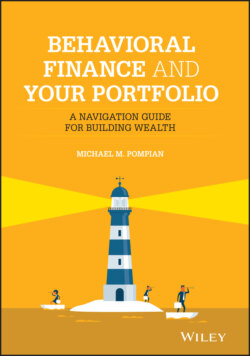Читать книгу Behavioral Finance and Your Portfolio - Michael M. Pompian - Страница 30
Behavioral Biases Defined
ОглавлениеThe dictionary defines a “bias” in several different ways, including: (a) a statistical sampling or testing error caused by systematically favoring some outcomes over others; (b) a preference or an inclination, especially one that inhibits impartial judgment; (c) an inclination or prejudice in favor of a particular viewpoint; and (d) an inclination of temperament or outlook, especially, a personal and sometimes unreasoned judgment. In this book, we are naturally concerned with biases that cause irrational financial decisions due to either: (1) faulty cognitive reasoning or (2) reasoning influenced by emotions, which can also be considered feelings, or, unfortunately, due to both. The first dictionary definition (a) of bias is consistent with faulty cognitive reasoning or thinking, while (b), (c), and (d) are more consistent with impaired reasoning influenced by feelings or emotion.
Behavioral biases are defined, essentially, the same way as systematic errors in judgment. Researchers distinguish a long list of specific biases and have applied over 100 of these to individual investor behaviors in recent studies. When one considers the derivative and the undiscovered biases awaiting application in personal finance, the list of systematic investor errors seems very long indeed. More brilliant research seeks to categorize these biases according to a meaningful framework. Some authors refer to biases as heuristics (rules of thumb), while others call them beliefs, judgments, or preferences. Psychologists' factors include cognitive information processing shortcuts or heuristics, memory errors, emotional and/or motivational factors, and social influences such as family upbringing or societal culture. Some biases identified by psychologists are understood in relation to human needs such as those identified by Maslow—physiological, safety, social, esteem, and self-actualizing. In satisfying these needs, people will generally attempt to avoid pain and seek pleasure. The avoidance of pain can be as subtle as refusing to acknowledge mistakes in order to maintain a positive self-image. The biases that help to avoid pain and instead produce pleasure may be classified as emotional. Other biases are attributed by psychologists to the particular way the brain perceives, forms memories, and makes judgments; the inability to do complex mathematical calculations, such as updating probabilities; and the processing and filtering of information.
This sort of bias taxonomy is helpful as an underlying theory about why and how people operate under bias, but no universal theory has been developed (yet). Instead of a universal theory of investment behavior, behavioral finance research relies on a broad collection of evidence pointing to the ineffectiveness of human decision making in various economic decision-making circumstances.
